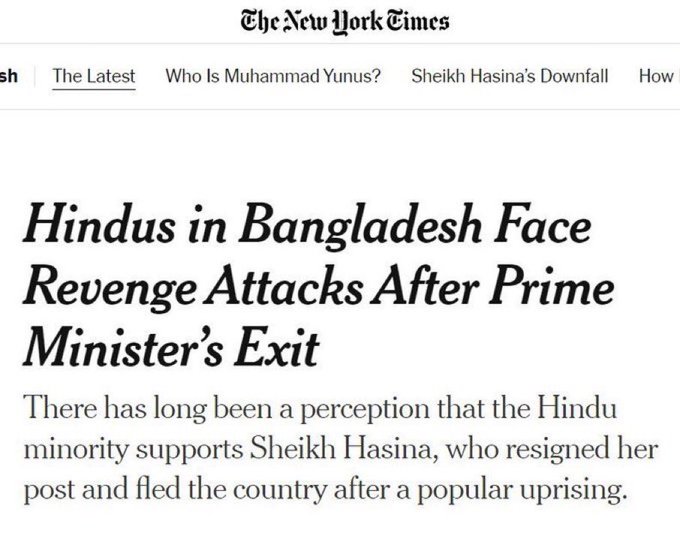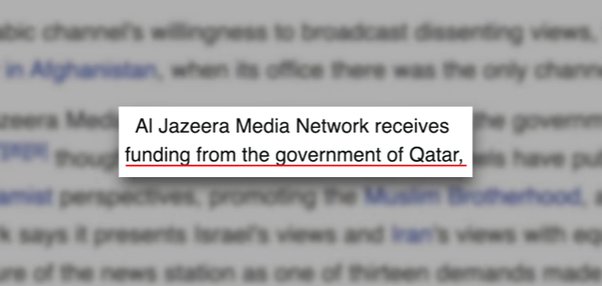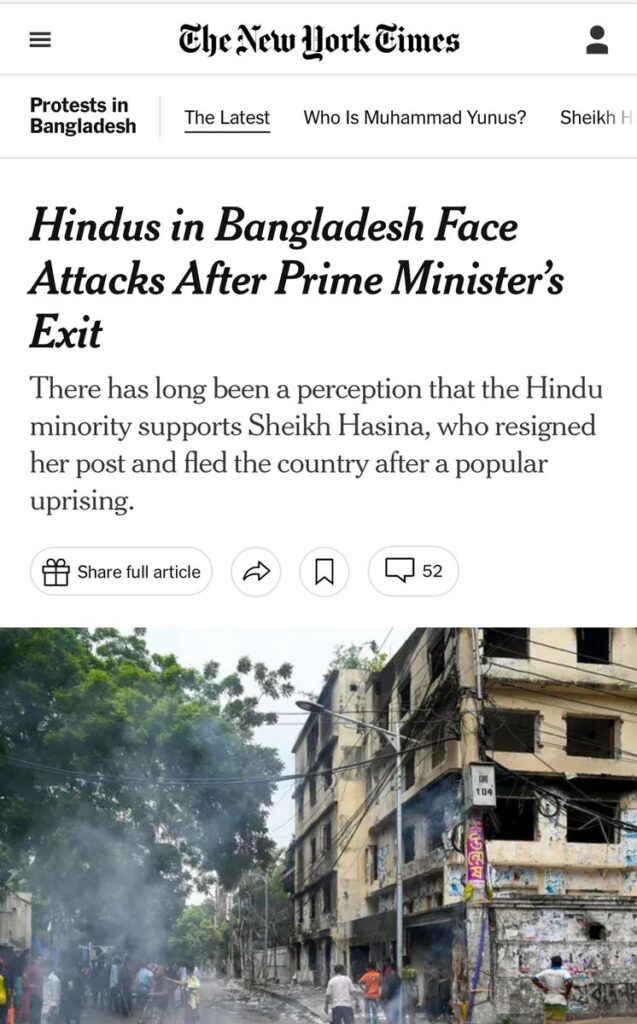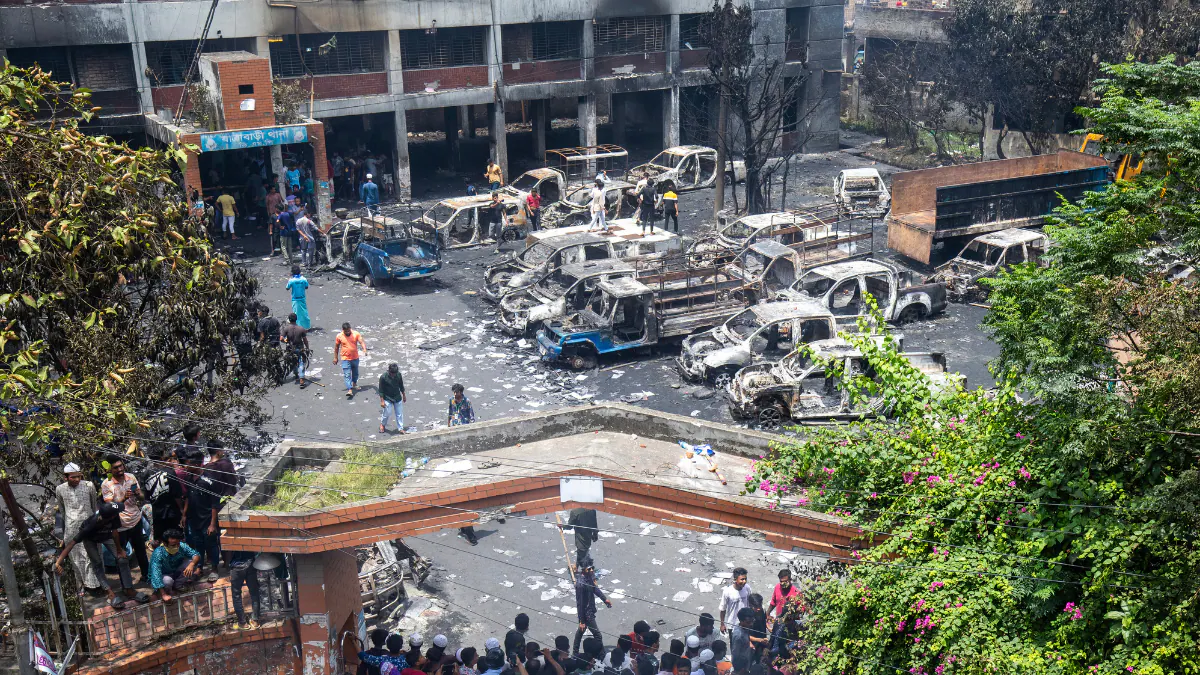By – SHubhendra Singh Rajawat
New York Times Bangladesh Hindus: The New York Times, an American newspaper, published an article on recent incidents involving Hindus in Bangladesh. In this piece, the publication referred to the anti-Hindu violence that occurred following Sheikh Hasina’s resignation as a revenge attack. Following this, the Western media has received a lot of criticism.
Bangladesh, India’s neighbor, is currently experiencing an unstable situation. Sheikh Hasina was just forced to resign as Prime Minister owing to a violent reservation campaign. The former Prime Minister has departed the nation and will remain in India. During the continuing unrest in Bangladesh, images of Hindus, their stores, and temples being targeted emerged from all around the country. However, the American daily New York Times just published an article on these attacks, which has sparked widespread criticism. As the outcry grew, the newspaper modified its report. This is not the first time that Western media has been questioned about its reporting in such circumstances.

What did the New York Times write about Hindus in Bangladesh?
On Thursday (August 8), the American publication released an article on recent incidents involving Hindus in Bangladesh. According to the newspaper, the anti-Hindu violence in Bangladesh following former Prime Minister Sheikh Hasina’s resignation was a retribution assault. The newspaper’s headline read: ‘Revenge attacks on Hindus in Bangladesh after Prime Minister’s resignation’. The English title read: ‘Hindus in Bangladesh Face Revenge Attacks After Prime Minister’s Exit.’
This story was widely attacked on social media and labeled anti-Hindu. Many individuals complained because the headline in the news implied that Hindus are criminals who should be attacked.
In response to the story, writer Sanjeev Sanyal commented, ‘So the NYT believes that the violence against Hindus is’revenge’… in other words, they must have done something wrong for which revenge should be taken.

JNU professor and author Happymon Jacob criticized the news, stating, ‘Sometimes hatred masquerades as revolution.’
Similarly, numerous social media users slammed the American publication, demanding an apology and clarification for the story.
What action did the New York Times take following the controversy?
Several hours after receiving criticism on social media, the newspaper amended the contentious title. The American publication removed the word revenge from the headline and wrote, ‘Attacks on Hindus in Bangladesh after Prime Minister’s departure.’ The English title read: ‘Hindus in Bangladesh Face Attacks After Prime Minister’s Exit.’

Has there been any biased reporting in the Western media before?
However, the Western media has already been accused of skewed reporting. On July 13, following the murder attempt on former US President Donald Trump, various media outlets, including the New York Times, were accused of biased reportage. The New York Times immediately reported, ‘Trump hurt but safe after shooting’.
The headline on CNN read, ‘Secret Service removed Trump off the stage after he fell at the rally’.
The Associated Press reported that “Donald Trump was taken off the stage during a rally after loud noises were heard in the crowd.”
The period when Trump was attacked was broadcast live. The TV footage showed the bullet passing close Trump’s ear. Bullets could be heard before he bent down to save himself. About a minute after being shot, Secret Service officials had him stand up. Trump had blood on his face as a result of an ear injury that was noticeable from a distance. However, CNN initially claimed that the former president had fallen.
The reportage of US newspapers on Jammu and Kashmir, which is an integral part of India, has also been questioned. In March of last year, the US daily published a piece about supposed limits on information technology in Kashmir. In reaction, Anurag Thakur, the then-Information and Broadcasting Minister, claimed that the New York Times was propagating misinformation about India. Anurag Thakur wrote on Twitter, “The New York Times had long ago abandoned all pretense of neutrality when publishing anything about India.” The New York Times’ so-called viewpoint on journalistic freedom in Kashmir is false. The essay was written solely to propagate propaganda regarding India’s democratic institutions and principles.
What happens to Hindus in Bangladesh?
On August 5, Sheikh Hasina announced her resignation as prime minister in the midst of the continuing student movement against Bangladesh’s reservation policy. The former prime minister fled the nation after resigning and traveled to India. On the other hand, as the country’s governments changed, minorities’ homes, businesses, and places of worship suffered vandalism. The prominent newspaper in Bangladesh, Daily Star, revealed that on August 5 alone, Hindu households and businesses in at least 27 districts were attacked by mobs, and their possessions were also taken.
Rahul Ananda, the frontman of the band Jollar Gaan, set his house in Dhanmondi, the capital of Bangladesh, on fire on August 5 and it burned down totally. The Daily Star said that this house was approximately 140 years old. Rahul made it to a safe haven with his family. Attacks on Hindu homes and businesses persisted even after August 5, and unsettling images were everywhere.


Hey people!!!!!
Good mood and good luck to everyone!!!!!